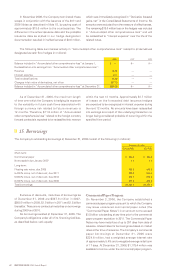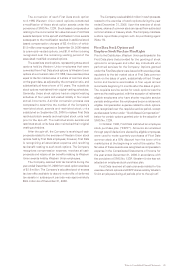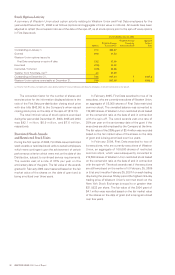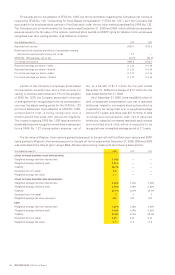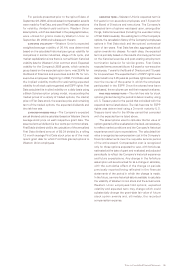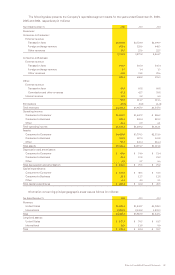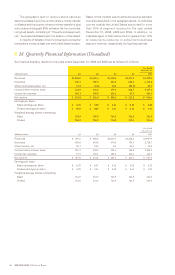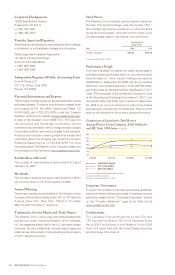Western Union 2006 Annual Report Download - page 98
Download and view the complete annual report
Please find page 98 of the 2006 Western Union annual report below. You can navigate through the pages in the report by either clicking on the pages listed below, or by using the keyword search tool below to find specific information within the annual report.WESTERN UNION 2006 Annual Report 96
|| 17. Segments
The Company classifies its businesses into two reportable
segments: consumer-to-consumer and consumer-to-
business. Operating segments are defined by SFAS
No. 131, “Disclosures About Segments of an Enterprise
and Related Information”, as components of an enterprise
about which separate financial information is available that
is evaluated regularly by the chief operating decision maker
(“CODM”) in deciding where to allocate resources and in
assessing performance.
|| The consumer-to-consumer reporting segment
provides money transfer services between consumers,
primarily through a global network of third-party
agents using our multi-currency, real-time money
transfer processing systems.
|| The consumer-to-business reporting segment
provides payments from consumers to billers through
a network of third-party agents and other various
electronic channels, including the telephone and the
Internet. While the Company continues to pursue
international expansion of its offerings in select
markets, such as the December 2006 acquisition
of SEPSA, substantially all of the segment’s 2006
revenue was generated in the United States.
The consumer-to-consumer reporting segment is
viewed as one global network where a money transfer can
be sent from one location to another, anywhere in the
world. The segment is managed as three regions, primarily
to coordinate agent network management and marketing
activities. The Company’s CODM makes decisions regarding
resource allocation and monitors performance based on
specific corridors within and across these regions, but also
reviews total revenue and operating profit of each region.
Each region and corridor offer the same services distributed
by the same agent network, have the same types of
customers, are subject to similar regulatory requirements,
are processed on the same system, and have similar
economic characteristics, allowing the geographic regions
to be aggregated into one reporting segment. Consumer-
to-consumer segment revenue typically increases sequentially
from the first quarter to the fourth quarter each year and
declines from the fourth quarter to the first quarter of the
following year. This seasonal fluctuation is related to the
holiday season in various countries in the fourth quarter.
All businesses that have not been classified into
consumer-to-consumer or consumer-to-business, primarily
the Company’s money order and prepaid services
businesses, and certain expenses incurred in connection
with the spin-off are reported as “Other.” The Company
previously operated internet auction payments, messaging
and international prepaid cellular top-up businesses. These
three businesses, representing aggregated revenues
in 2006, 2005 and 2004 of $4.1 million, $28.9 million
and $35.4 million, respectively, and operating income/
(losses) before taxes of $0.1 million, $(16.2) million and
$(8.2) million, respectively, were shut down or sold in 2005
and early 2006 and are included in “Other.” Due to the
immaterial nature of these three businesses, they have
not been presented separately as discontinued operations.
The Company’s reportable segments are reviewed
separately below because each reportable segment
represents a strategic business unit that offers different
products and serves different markets. The business
segment measurements provided to, and evaluated by,
the Company’s CODM are computed in accordance with
the following principles:
|| The accounting policies of the reportable
segments are the same as those described in
the summary of significant accounting policies.
|| Segment revenue includes intersegment
revenue.
|| Corporate and other overhead is allocated to
the segments primarily based on a percentage
of the segments’ revenue.
|| Certain non-recurring costs incurred to effect
the spin-off are not allocated to the segments.
|| Exclude all items not included in operating income.




